7 Steps to Spot the Trends that Will Transform Your Business

It was the 2008 financial crisis. My mortgage business had gone bust. I was forced to lay off 120 employees, had lost all my assets and investors, and was over a million dollars in debt.
“So, what are you going to do next?” Verne Harnish asked me over the phone after I told him what had happened.
“I’m moving back to Mexico. I’ll look for a job. There’s nothing left for me to do here in the US,” I answered matter of factly, thinking it was the obvious answer.
“You should become a coach,” countered Verne.
I was shocked. I didn’t trust myself to be an entrepreneur. How could I become a coach after what I’d just experienced?
“Your experience is precisely why you need to make sure it doesn’t happen to someone else,” Verne affirmed.
His encouragement became the seed that eventually grew into co-founding Growth Institute with Verne. Since then, we've helped over 40,000 executives from 10,000 different companies in 65 countries overcome the challenges to scale their business.
Today, as many countries face an economic crisis triggered by the pandemic, I feel the responsibility to share what I learned from my mistakes and what I now know about managing a company to survive a crisis.
I recently co-hosted a workshop with fellow Scaling Up Coaches; Anna Samios, Lisa Foulger, and Herb Cogliano to cover a very important tool every business leader needs to use right now: the SWT tool.
Here are the key points we covered.
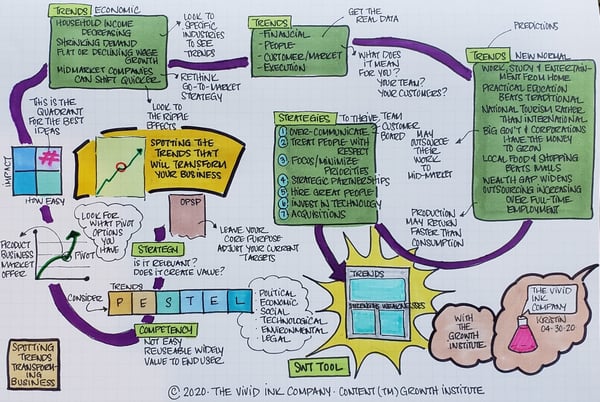
Visual summary by Kristin McLane of The Vivid Ink Company.
Follow her on Facebook and LinkedIn for more learning snapshots.
How the SWT Tool Can Save Your Company During this Crisis
The first thing you need to do during this crisis is to analyze what needs to change and what does not.
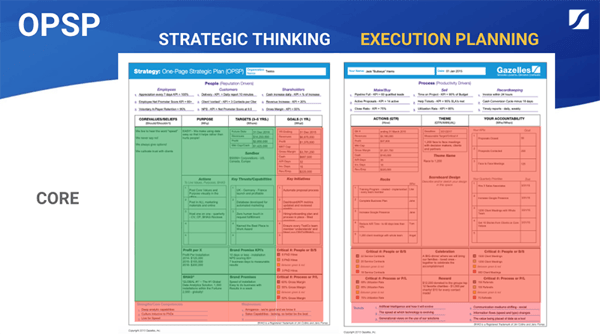
This is a snapshot of the One-Page Strategic Plan (OPSP). With the current economic crash, what you’ll need to change are the execution planning components, which are marked in red. Everything else marked in green can remain the same because strategic thinking is who you are and what you want to achieve. What needs to be challenged is how you get there.
Today, we’ll be diving deeper into the SWT aspect of execution planning. SWT stands for strengths, weaknesses, and trends.
By using our SWT tool, you can identify the new trends that your company should be taking advantage of, right now. Thus, the SWT helps you formulate a new strategy that will pull your business through the crisis.
Here’s how two Growth Institute clients used the SWT tool to restrategize and turn things around for their company.
Rick Jameson
Rick Jameson’s company in Canada supplied parts to automotive companies. When most of the factories closed down, his business significantly dropped. Using the SWT tool, he aligned his strengths to meet new trends and pivoted to build ventilators. He invested in a ventilator patent, brought the patent to Canada, and then secured a $235 million government contract to manufacture ventilators.
Paul Binsfeld
Schools were Paul Binsfeld’s main clients. When all the schools closed due to the coronavirus, his revenue dropped by 50% in a week. His Scaling Up coach, Jason, guided him through the SWT tool. The tool helped Paul identify the trends that his business could leverage to regain the lost revenue.
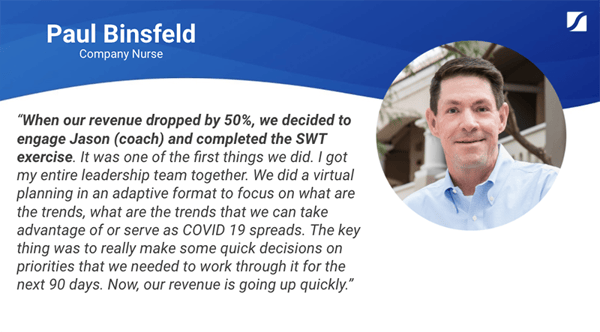
This is how powerful the SWT tool can be. Now, I know you might be wondering how the SWT tool is any different from the traditional SWOT analysis. That’s what Herb Cogliano, Scaling Up Coach & Managing Partner of Aspire Growth Advisors, LLC, taught during the workshop.
The next few sections will cover Herb’s insights into the SWT tool, as well as a comprehensive walkthrough on how to use the tool plus the technology trends to look out for. .
Why SWT is Superior to SWOT During a Crisis
The traditional SWOT tool — which stands for strengths, weaknesses, opportunities, and threats — is still an important part of planning by middle managers. However, SWOT can sometimes create industry myopia because it influences your team to focus primarily on your company and its industry.
The SWT tool allows a broader perspective to spot trends in other industries and distant markets around the globe. While SWOT helps you to see the forest from the trees, SWT helps you to see the world beyond the forest.
With the SWT tool, you’ll review trends across six categories. This helps your team create perspective by discussing long-range impacts each category could have on your business. You’ll then be able to identify the right trends to leverage by matching it with your company’s inherent strengths and weaknesses.
Thus, the value of the SWT tool is to help to recognize core competencies within your strengths and put them to good use in your strategy creation. Let’s now run through the SWT exercise step by step.
Step 1: Identify Your Core Competency
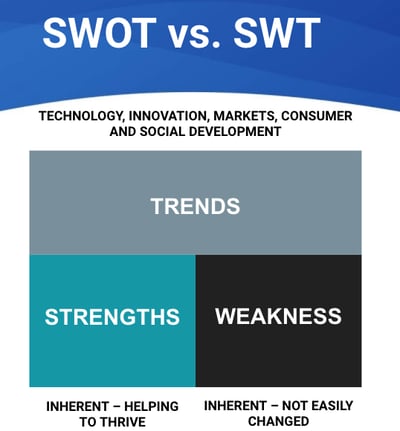
Using the SWT tool, the first step is to write down your company’s top three inherent strengths and weaknesses.
Once you’ve done that, the next step is to identify which of your inherent strengths is your core competency. Your core competency can be identified based on how it can be replicated across different product categories or markets. Here are some examples of companies and their core competencies.
Honda’s core competency is building small engines. By leveraging their core competency and identifying the trends of different global markets, they have successfully put small engines into cars, motorcycles, lawnmowers, and a lot more.
Sony is a company whose core competency lies in miniaturization. Similarly, they’ve been able to offer different products by miniaturizing their technology for television, radios, cameras, and more.
The last example is BIC. Their core competency lies in producing low-cost consumable plastic products. This core competency has enabled them to become a global success in producing pens, shavers, lighters, and many other product categories.
To identify your core competency, look for the inherent strength that has the following three attributes:
- It's not easy for a competitor to imitate.
- It can be reused widely in many products in many markets.
- It will contribute benefits to the client experience
Identifying your core competency gives direction for the next step, which is how you can pivot your company.
Step 2: Brainstorm Different Pivot Strategies
There are four types of pivots your company can make to survive the crisis:
- Product Category Pivot
Example: Pivoting from manufacturing window shades to manufacturing face shields. - Business Model Pivot
Example: Pivoting from selling medicine in a brick and mortar clinic to telemedicine online. - Market Pivot
Example: Pivoting from serving enterprise large accounts to serving small, medium business accounts. - Offer Pivot
Example: Pivoting from selling your items individually to creating bundles.
Based on the core competency you identified, brainstorm with your team different ways your company can pivot for each pivot type. Write them into the following grid according to how easy it is to implement and how much impact it will have on your company.

The ideas you want to focus on are the ones in the top right quadrant because these will be the ones that will create the most impact while being the easiest for your team to implement.
You may end up with more than one idea in the top right quadrant. How do you choose which one to focus on first? This is where evaluating trends will help you decide.
Step 3: The Global Trends You Can’t Afford to Ignore
When using the SWT tool, you want to consider trends across the following six categories:
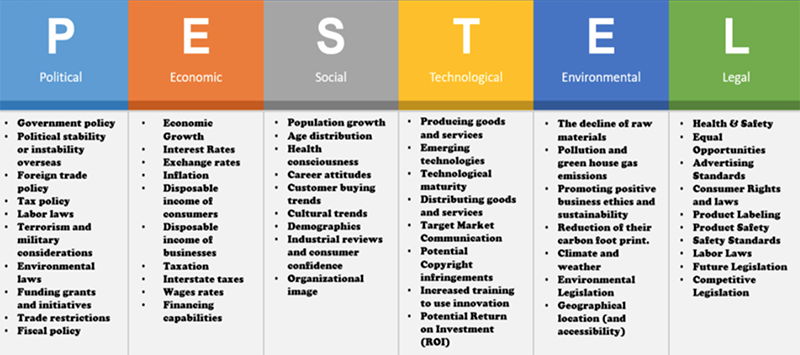
We won’t be diving into each one. However, we will briefly cover some of the biggest current global trends as well as shifts that have happened due to the COVID-19 pandemic. Most importantly, we’ll look at how it can impact businesses.
Technology Trends
- AI and Machine Learning
There are many ways you can adopt AI and machine learning into your current offerings or operations. One of our clients is leveraging AI and machine learning for client listening programs.
They scour the world for any mention of their company or brand name, and then they review the words around it to determine negative or positive customer sentiment. They then grade the impact of their marketing campaigns accordingly. They're also using this technology to identify their competitors’ weaknesses so they can take advantage of those areas of weakness. - Robotics
Robotics is influencing not only how industry workspaces operate but even in the home environment. - Wearable Technology
From smartwatches to electronic textiles that provide added value to the wearer, these wearable technologies can collect various data that can be used for wellness and illness prevention. - 3D Printing
The revolution of customized on-demand printing anywhere in the world offers a wealth of innovation and opportunity across many industries, from jewelry to the gift market, automotive, healthcare, and more. - Genomics
The rapid development of genomics is increasing accessibility for people to uncover potential illnesses in their DNA. This can impact various industries, from wellness to insurance and even transplants.
Macro-Economic Trends
Next, are the macro-economic trends. Anna Samios, a Scaling Up Coach, Entrepreneur & Speaker, shed her insights on this during the workshop. Here they are below.
- Household disposable income
Household disposable income has definitely been hit the hardest. It’s likely due to the rising unemployment figures and the subsequent declining consumer confidence. It is also linked to how confident people are in keeping their jobs over the next 12 to 18 months. When consumer buying power declines, the impact upon businesses will be very big, particularly for mid-market companies.
This is because mid-market companies don't have the economies of scale or the bargaining power to offer highly competitive prices. However, the advantage that mid-market companies do have over the bigger players is the ability to respond or pivot faster and quickly tap into strategic partnerships. - Domestic demand, inbound tourism
With lower household disposable income, domestic demand will reduce. Combine this with a lack of inbound tourism due to travel restrictions and fears of travel, and the result is the slowing down of many markets. In particular, the property and investment markets will be hit the hardest. In the short-term, you’ll see many people “sitting on their eggs” until business confidence rebounds.
- Working & social behaviors
Working from home is the new flavor of the month. In the short-term, retail and commercial leases will also be affected. However, this might not mean an absolute collapse in commercial space in the long-term. It is likely for a hybrid model to emerge where employees have the option to choose how they'd like to work. This hybrid model could also impact how people socialize and spend their time in recreational play. - Consumer buying tastes and behaviors
The shutdown has changed what people think they truly need and what they want. It has also changed how they access their needs and wants. While e-commerce has been around for a long time, the bricks and mortar stores are now feeling the pressure of moving into e-commerce offerings.
In terms of consumer behavior pivots, there’s been a surge in spending on fitness apparel. Other industries that are now booming include online gambling sites, alcohol consumption, video games, pet grooming, animal rescue, and television streaming services. This change in spending habits and buying behaviors will impact strategies moving forward in our post-COVID world together. - Live arts, entertainment, and hospitality industries
The live arts and entertainment industry have been hit the hardest by the new social distancing restrictions. A lot of hospitality industry players are also the first to be shut down. These industries will likely be the last to get back to full capacity.
Each of these trends will create a ripple effect that can impact your business. Evaluate all these trends, as well as the trends in the PESTEL analysis framework. Then, identify the top six trends that can have the biggest impact on your company and industry. Write these down in the “trends” portion of the SWT tool.
Step 4: The Trends that Can Optimize Your Operations
In the previous steps, we looked at the trends that affect the external conditions of your business. Next, let’s explore the trends that affect your internal operations. Now is the ideal time for leaders to buckle down and utilize data to drive insight.
Lisa Foulger, a Scaling Up Coach and an executive leadership & entrepreneurial growth coach explored each trend on a deeper level during the workshop. Here’s what she presented.
Internal Operation Trends
- Financial data
The trend is moving toward scenario planning where companies are segmenting the industries they're performing in to understand how they've been impacted. By utilizing financial data this way, they can plan for worst-case scenarios and then dial it back for better case scenarios. - People data
Many companies are now buckling down and utilizing people data, from behavioral assessments to modeling people analytics. The end goal of leveraging these data is to drive better collaboration, communication, and engagement. It can even give you data when you have to make really tough decisions around reducing your team and how to optimize your team to create the best impact. The more you understand your people, the better you can communicate and connect with, care for, and support them. - Customer/market data
Understanding people ties into understanding your customers and market. What are the ripple effects that your customers experience under the current macro changes? How does it impact their immediate environment, feelings, behavior, and thinking? Getting these insights can be critical in how you choose to restrategize. - Execution data
This is where having a dashboard becomes critical. Dashboards provide real-time relevant data that reveal opportunities and threats in a timely manner. It provides fast feedback, which lets you know what you need to focus on each day, allows the team to operate efficiently, and creates a culture of accountability. - Trust
The value of building trust with your team, customers, and clients has never been higher. Right now, people are very vulnerable. It is a beautiful time to authentically reconnect, strengthen relationships, and demonstrate caring. When you invest time and effort into building trust, it pays off tremendously.
With many things slowing down, you have the opportunity to step back and sow seeds. Use this time to analyze all your data and spring clean your processes. Invest time to connect and listen to your team members and favorite customers or clients.
Step 5: Align Your Company to the New Normal
This wraps up what you need to know about filling out a strategically powerful SWT sheet - with added critical insight from our Scaling Up coaches.
Now let's talk about how to turn these insights about the market into reality for your business.
What you will need next is a new execution plan to adapt to the new normal. The new normal is inevitably coming, and if you adapt to it now, you’ll set yourself up to become the market leader. I call it the CNN effect.
When CNN first launched in the 1980s, it was losing a lot of money. Consumers had no desire to access the news 24/7. They were accustomed to getting their news at the beginning of the day with newspapers, or at the end of the day through the late evening news.
Then, the Gulf War happened and people were glued to CNN’s live coverage. Consumer behavior shifted for good. CNN revolutionized the news reporting industry and positioned itself as the market leader.
This pandemic is creating another CNN effect. There will be a new normal, and you need to align your company now to the new normal. How? I suggest executing seven specific strategies that will help make your company agile and adaptable, so your business can thrive after the crisis.
Step 6: 7 Strategies to Thrive After the Crisis
As you work to make your company agile, you’ll want to update your leadership style. Take on these 7 strategies to get that much closer to adapting to the new normal.
- Over-communicate
Over-communicate with your team, customers, and shareholders. Increase the frequency of your communication rhythm. Panic is contagious, but when you lead with transparent and frequent communication, you’ll foster calm, focus, and productivity.
- Treat people with respect and empathy
During a crisis, everything gets amplified; the good and the bad. People are going to remember how you treat them in bad times. So if you treat your employees, community, or clients the wrong way, they’ll remember it for years to come. - Focus and minimize priorities
Establish the Pareto 80:20 rule. Focus on the 20% of strategies that will give you an 80% impact. Conserve the balance 80% strategies for when you come out stronger. - Strategic partnerships
People are looking for different ways to make money. This makes them much more open to new ideas and initiatives. When executing your new pivot strategy, don’t limit yourself to your current circle. Think outside the box and strike new strategic partnerships to create new opportunities. - Hire great people
There's going to be a lot of great people who are available in the market or are considering a change. Now is the right moment to put together the strategic team you need to be able to grow your company. So look out there and get the right people on board. - Invest in technology for the new normal
Use this time to accustom your employees, customers, and stakeholders to operate differently with technology. Now is the time they are more open to change. - Acquisitions
It may not be the right time for acquisitions right now. However, acquisition opportunities are going to be amazing in the next 12 to 24 months. Do whatever you can to stay alive so you can survive the next 12 to 24 months with enough cash flow, then look for opportunities to acquire competitors and real estate.
Step 7: Implementing Your New Direction
Pivoting your business with a new strategy requires a lot of changes to be implemented in a short time frame. Even if you come up with the best new strategy, if you don’t implement it properly, a lot of drama and chaos can ensue.
If you would like support on how to implement your new pivot strategy in a way that reduces drama, aligns your team, and optimizes operations in the new normal, learn more about our Scaling Up Master Business Course below.
I’d like to wrap up this article by sharing a resource guide to further support you during this crisis. We hope you will find these useful, and if you do, please share it with all the business leaders you know.
Resource Guide
- Download "Surviving an Economic Downturn with Talent Optimization" that Lisa Foulger recommended
- Here is the Outthinker Impact Grid that Herb Cogliano used to segment market opportunities
- Read Great by Choice by Jim Collins
With particular focus on the following chapters: - 20 Mile March
- Bullets and Cannonballs
- Luck




